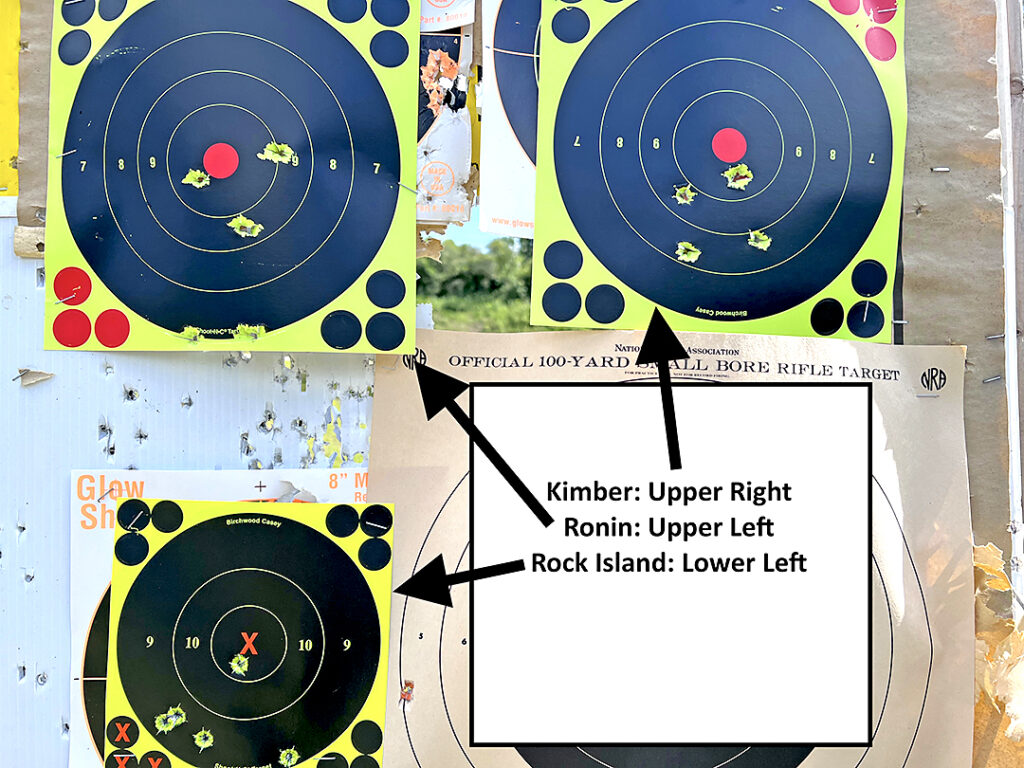Length, width or weight?


“Just for the fun of it, let’s see how three guns with different length barrels compare when shot at 7.5 yards,” suggests Joe. “We’ll use the same inexpensive 115-grain 9mm Luger full metal jacketed ammunition on all.”
I’m up for trying out new guns. My first thought is that the longer the barrel, the better he’ll shoot. Will this turn out to be so? Then I’ll shoot all three as well.
Joe brings out the three guns he plans to compare.
“But they’re all hammer guns,” I complain. He well knows I prefer striker-fired guns.
“Them’s the breaks,” Joe says happily. He prefers hammer-fired guns. “All three are the genius of John Moses Browning. And I say that in the most venerable way.”
I sigh.
“OK. What are we shooting today?”
He pulls out a:
- 1911 Kimber Government model with a 5 inch barrel,
- a Springfield Ronin Commander model with a 4.25 inch barrel, and
- a Rock Island Officer model with a 3.5 inch barrel.
First of all, the length can make a difference with accuracy. The weight of the gun can make a difference as well, because the mass of the gun can absorb some of the recoil, and thus help us to shoot more accurately.
Now, if it’s length as your criteria, the Kimber would win hands down.
But if mass is your criteria, the Ronin is the heaviest of the three; even with a barrel shorter than the Kimber’s.
And if thickness of the barrel is most important to you, the Rock Island wins out. It has a nice, thick, heavy bull barrel.
Which is not to discount that Ronin’s barrel is thicker than most, but not so thick as the Rock Island.
Personally, I’d bet that Joe is going to prefer the Kimber. After all, it’s a Kimber: right? And how many men (and some women) just about genuflect when they hear the name?
I’m going to bet on the Ronin. It has a shorter barrel, but that barrel is a lot thicker than the Kimber’s.
And next, I’ll bet on Rock Island because it has the heaviest barrel of all, even though the barrel is shorter than the others.
So, sorry Kimber. I like a heavy barrel more than a longer one.
Let’s talk overall weight, unloaded. - Kimber weighs 38 ounces,
- Ronin 40 ounces, and
- Rocky 34.6 ounces.
Notice that though Kimber is three-quarters of an inch longer than Ronin, Ronin is heavier. Rocky, with its very heavy bull barrel, weighs the least, but remember Rocky is three quarters of an inch shorter than Ronin and 1 and a half inches shorter than the Kimber.
Will the heavier but shorter Ronin show more accurately than the Kimber?
For a bit more history, Kimber comes with a 9-round magazine, Ronin with a 9-round mag and Rocky with an 8-round mag. Frames and slides of all three handguns are made of metal. All three are considered 1911 models. This means grips are 18 degrees off perpendicular, and they all have grip safeties as well as manual safeties. Triggers are called “bowed” and are not hinged. They go straight back.
“That’s why they are the finest triggers in the world,” Joe pontificates smugly.
Well, yes, the 1911 triggers do feel crisp and not grainy, and are reasonably light and have short travel. But a trigger isn’t the only criteria for a good handgun. I still prefer a striker-fired gun; even if the trigger isn’t quite so smooth.
Anyhow, we’re both going to shoot today. Joe starts out with five shots on each gun. Upper left are the results from Kimber, upper right is Ronin and lower left is Rocky.
Kimber has a double in the x-ring, two in the 8-ring and one in the 9-ring. (If the hole touches the higher-level ring, it’s considered the higher number.)
Ronin (upper right) has a nice grouping of three with two in the x-ring and one in the 9-ring. Since the other two shots are barely on the target, I believe that’s shooter’s error. I think it reflects on unfocused shooting and not on the ability of the gun.
Joe shoots a x-ring with the Rocky and the other four shots are in the 9-ring. Notice this lower target is the smaller 6 inches, where the other two targets are 8 inches in diameter. He’s shooting low here, but they show a good tight grouping.
Next, I shoot three rounds each with each handgun; all in the same 8 inch target. I get three bullseyes: one with each gun. Next are: three in the 9-ring and two in the 8-ring. One is barely on the target. That was an “oops!”
Likeability?
Kimber and Rocky have grips that are wide front to back. Since Joe has a large hand, he likes the grips. I find the Kimber too wide for comfort, and the Rocky even wider.
Ronin has a narrower grip. This gives me a more controlled hold, and Joe also says that even though the grip is narrow, he still has great control of the gun.
Trigger pull on the Electronic Lyman Digital Trigger Pull Gauge is: - 5 pounds, 4 ounces for Kimber,
- 4 pounds, 13 ounces for Ronin, and
- 5 pounds, 4 ounces for Rocky.
These are all easy, clean pulls on single-action guns. It is easy to rack the slides on each of them.
Everyone I talk to wants to know about recoil. “How hard is it?” they ask. “Could I practice on it comfortably for an hour?”
Rocky has the hardest recoil. It’s not a hard recoil: it’s simply the most recoil of all three guns.
We noticed no failure-to-feeds or failure-to-ejects. We had no feeding problems at all.
It might be nice to say that one of these guns is better than the others. Since all have similar trigger pulls, all have easy-to-rack slides, and not-too-hard recoils, the best gun for you will be the best gun that fits in your hand. Ronin fits my hand the best. Joe has no problem with any of the grips.
Bottom line is: I like the Ronin with its thick barrel the best. Joe likes all three guns, but I have a sneaking suspicion that he prefers the Kimber.
“It’s extremely steady in my hand,” he reports. “It has a great balance.”
And, not to be superficial, it sports the name: Kimber.
Marj Law is the former director of Keep Wakulla County Beautiful who has become an avid shooter in retirement.


